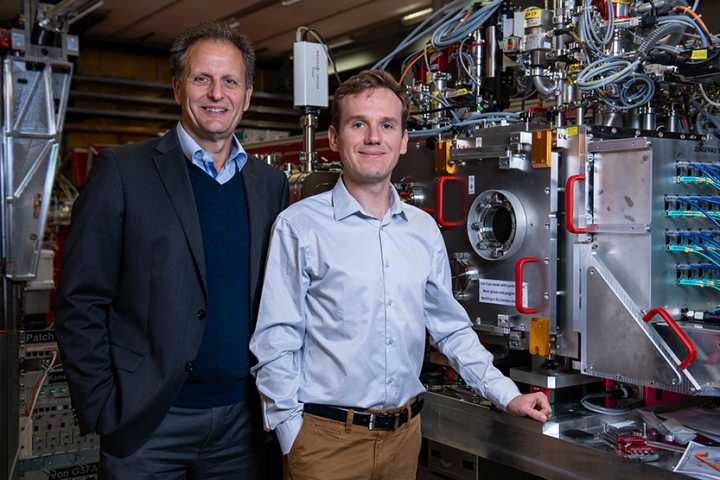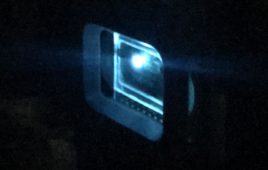
Michael Hennig (left) and Karol Nass at the experiment station in SwissFEL where their pilot experiment was conducted. Image: Paul Scherrer Institute/Mahir Dzambegovic
For the development of new medicinal agents, accurate knowledge of biological processes in the body is a prerequisite. Here proteins play a crucial role.
At the Paul Scherrer Institute (PSI), the X-ray free-electron laser SwissFEL has now, for the first time, directed its strong light onto protein crystals and made their structures visible.
The special characteristics of the X-ray laser enable completely novel experiments in which scientists can watch how proteins move and change their shape.
The new method, which in Switzerland is only possible at PSI, will in the future aid in the discovery of new drugs.
Less than two years after the X-ray free-electron laser SwissFEL started operations, PSI researchers, together with the Swiss company leadXpro, have successfully completed their first experiment using it to study biological molecules.
With that, they have achieved another milestone before this new PSI large research facility becomes available for experiments, at the beginning of 2019, to all users from academia and industry.
SwissFEL is one of only five facilities worldwide in which researchers can investigate biological processes in proteins or protein complexes with high-energy X-ray laser light.
In the future, the extremely short X-ray light pulses of SwissFEL will allow us here at PSI to capture not only the structure of molecules, but also their movement, says PSI physicist Karol Nass, who led the experiment.
That will enable us to observe and understand many biological processes from a completely different perspective.
This opens new possibilities for pharmaceutical research in particular. Michael Hennig, CEO of the biotech company leadXpro, is convinced of that.
The company, headquartered in Park innovaare at PSI, is investigating the structure of certain proteins that take on important functions in the cell membrane and are therefore suitable targets for drugs.
That is why he has already, in this first biological experiment at the new SwissFEL facility, closely examined a membrane protein that plays an important role in cancers.
Membrane proteins are involved in many biological processes in the body and thus are the key to new treatment prospects; several Nobel Prizes have already been awarded to researchers who have studied them.
They are protein molecules that are firmly integrated into the cell membrane and are responsible for communication between cells and their surroundings. When a medicinal agent docks on them, for example, they change their shape and in doing so send a signal into the interior of the cell. That influences the cell metabolism and other cellular functions.
Many drugs in use today already work via membrane proteins. However, not much is known in detail about what changes the agents trigger there. You know which agent is binding and what effects it causes, yet the signals are transmitted through structural changes of the protein.
What exactly these are, we can only guess, Hennig says.
With SwissFEL, researchers want to better understand these ultrafast dynamics with which drugs couple to membrane proteins, as well as the associated mechanisms. With this knowledge, the researchers hope new and more targeted agents against diseases can be developed, and side-effects can be minimized.
To make the structure of complex proteins visible, researchers up to now have used a method in which they look at proteins with the help of a facility producing synchrotron light — also at PSI.
For this method, proteins are prepared so that they are available in crystalline form — that is, arranged in a regular lattice structure. When the X-ray light of a synchrotron strikes them, this light is scattered at the crystal lattice and caught by a detector.
The detector then delivers the data to a computer for a three-dimensional image of the protein structure.
This basic principle is also applied at SwissFEL. Compared to a synchrotron, though, SwissFEL sends X-ray flashes with billion-fold higher intensity in very short intervals, up to 100 flashes per second. These destroy the crystals after every flash.
Therefore as many as hundreds of thousands of crystals of a protein must be brought successively into the X-ray beam. Every flash that hits a protein, just before destroying it, produces a scatter diagram at the detector. This is analyzed by complex software running on high-performance computers and then computed into a structure.
Since the pulses are unimaginably short, even very fast molecular movements can be made visible as if in slow motion.
The Jungfrau-16M detector at SwissFEL is the newest and largest detector in the world for the investigation of biomolecules with an X-ray laser. Researchers at PSI spent more than five years developing the 16-M detector specifically for this application. It was completed in June 2018.
Then it took only two months before it was able to successfully demonstrate its capability — with this first biomolecule experiment at SwissFEL.
This detector is something special, says Nass. It has a low noise performance and a very high dynamic range, and as a result it can record a much larger bandwidth of intensities.
This is like a camera that can process very large light-dark differences. This characteristic is especially important for measurements at SwissFEL because of its extremely high light intensity.
Besides the highly sensitive detector, biological researchers at SwissFEL appreciate the possibility to analyses much smaller crystals than at a synchrotron.
This aspect is also interesting from an economic perspective, Hennig finds, since depending on the protein, finding a procedure to grow crystals from it can be extremely time-consuming.
For some proteins, up to now, only small crystals could be produced. Now researchers can study these at SwissFEL. Thus they save an enormous amount of time that otherwise would be necessary for the optimization of the crystal, so they get the results faster.
For leadXpro, the collaboration with PSI, including access to the large research facility SwissFEL, is a win-win situation in which the areas of expertise perfectly complement each other. Already in this pilot experiment, a leadXpro researcher crystallized the proteins and prepared them for analysis in order, to jointly examine them with PSI scientists at SwissFEL.
Hennig says, “With our experiments, we are showing that at SwissFEL, simultaneously with fundamental research, it’s possible to do applied pharmaceutical research that will benefit patients.
“One day, as a result, agents should be discovered that lead to major improvements in the treatment of diseases — by influencing tiny movements in the proteins.”
Source: Paul Scherrer Institute


